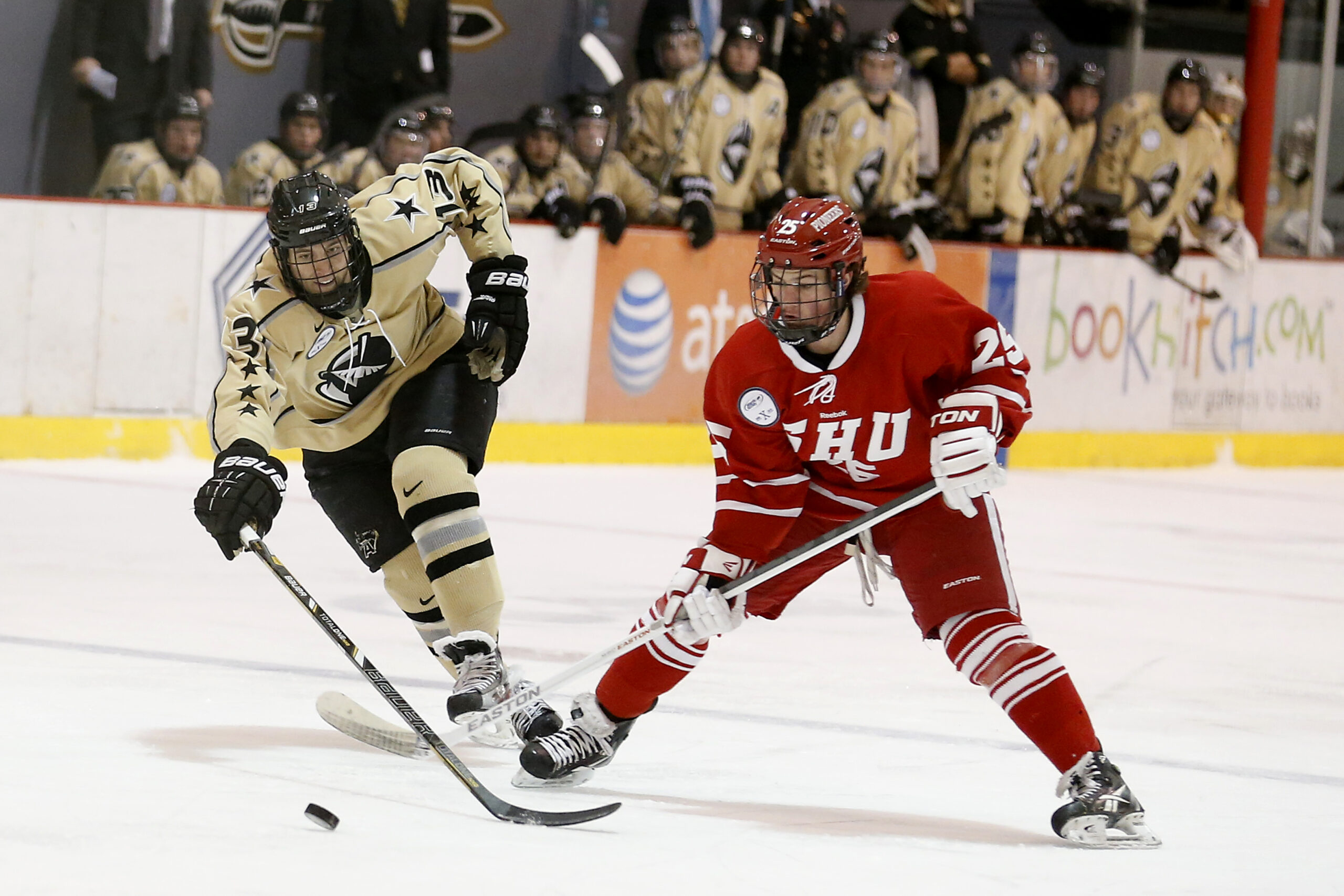We have explored many types of maneuvers teams use, or try to use, to obtain advantages when it comes to managing the salary cap. These include utilizing LTIR and the player returning for playoffs, the trade and return, and cap retention in trades. But a not-so-new, somewhat rare, maneuver has now surfaced. So let’s dive into NHL teams’ abilities to defer salary to save on the cap hit.
Deferring Salary on the NHL’s Standard Player Contract
On August 31, 2024, the Carolina Hurricanes re-signed RFA Seth Jarvis to an eight-year deal. Sure, signing the young player with a bright future long-term was big news. However, arguably, the most interesting aspect was how Hurricanes general manager Eric Tulsky actually orchestrated a deal that included deferred salary. What this means is the annual average value (AAV) cap hit is lower even though in the end the actual amount paid is more. They used the same mechanism in signing star defenseman Jaccob Slavin a little earlier, but the effects were minimal and went almost unnoticed. So this was reportedly the first deal to use this deferred salary mechanism in the salary cap era. But if the player makes more money in the end and the team saves on their cap hit, why isn’t this used more? Let’s dive a little deeper.
How Deferred Salary Works in the NHL
Typically, figuring out the AAV for an NHL contract is simple. You take the total value of the contract and divide it by the term. In Jarvis’s case, his deal is eight years at $63.2 million. This would normally equal an AAV of $7.9 million. But the AAV here will actually end up being $7.5 million due to the deferred salary.
The NHL/NHLPA CBA allows deferred payments under sections 50.2(a)(ii) (“Deferred Salary”) and 50.2(b)(i)(A) (“Deferred Bonuses”). Deferred compensation has actually been available since the implementation of the salary cap in 2005. Jarvis’s deal will defer some payment to be paid out one day after the expiration of the contract. So technically in year nine. In fact, the CBA requires any amounts deemed “Deferred Salary” or “Deferred Bonuses” to be paid after the expiration of the term of the contract. If it is deferred in one year but paid another year during the term, it is not deferred salary.
The Deferred Compensation Adjusted Cap Hit
But this means that the deferred payment is not charged against the cap to the eight-year deal. It is only the amount actually paid over that time that is. The deferred amount must come out of a, or multiple of, specific year’s amount, not just generally out of the total amount. The NHL requires these deferred payment calculations use a time-value of money discount. Time-value of money is a concept that simply says you’d rather have a dollar today than a dollar tomorrow. In theory, that dollar if received today could be invested and worth more than if received tomorrow.
Time-Value of Money
So, the NHL calculation for the cap hit looks at the amount deferred and discounts the value of that deferral in the year the contract is signed based on an interest rate. This was originally the London Interbank Offered Rate (LIBOR) for the time of the deferral (i.e. time period extended beyond the contract term) plus 1.25%. But now with LIBOR abolished, the deferred salary discount rate is a different amount. Most believe the NHL set its own rate. This rate accounts for the estimated growth rate that would get a current sum up to that deferred amount.
It is possible that the contract for the deferred salary arrangement could include an interest rate to adjust the deferred payment itself. In that case, the discount rate would not apply and the cap savings would be gone. It’s important to note that the final deferred payment is still the responsibility of the team who signed the player (unless traded) but there is no cap hit in that deferred year.
Puckpedia has a great tool to look at deferred salary calculations. If you look at Jarvis’s you can see how this works. At the end of the day, its relatively simple to calculate. It’s not so simple, however, to agree on what year the deferrals should be pulled from and ultimately paid out. And how much.
The Negatives and Risks
So this sounds great for teams as they save on their cap hit per year. It also sounds like a good deal for the player as they ultimately make more money. For example, if Jarvis’s AAV was at its current $7.5 million with no deferral, the total amount paid would be $60,000,000. But under this arrangement, he will make $3.2 million more. However, the reason this carries risk to the player is the very concept of time-value of money.
Once Again…..the Time-Value of Money
Under this arrangement, the player is essentially relying on the NHL’s discount rate as their rate of return on their deferred salary. If the NHL’s rate is 6%, but the player could invest that money at 10%, they are actually losing potential money. Under Section 50.4(a) of the CBA, these deferred amounts, while discounted for AAV, do count in the players league wide compensation for the year earned, not paid. Which long term could affect escrow payments and balances. Also, under Section 50.4(d), the deferred salary or bonuses may be adjusted in the year earned if there is a shortfall or overage (defined in Section 50.11 of the CBA), even though there will not be any withholding for escrow.
Deferred Compensation Tax Risks
Section 11.21 of the CBA provides amendments to standard player contracts (SPC) to account for deferred compensation arrangements falling under the purview of Internal Revenue Code Section 409A (for nonqualified deferred compensation). The specifics of those rules are a subject for another day but it is important to just note that these deferred payments that fall under 409A and may be considered deferred compensation in any capacity by the IRS or Department of Labor in the U.S. run their own sets of risks with big penalties if not handled appropriately.
This is different than the NHL’s pension or other retirement plans, but still falls under those laws in various capacities. Within that comes the fact that teams cannot deduct these deferred payments for taxes until the year they are actually paid. And due to the guaranteed nature of the deferred payment, the team is on the hook for this payment no matter their financial situation at the time (even though insurance plays a big role here too).
Potential Cap Circumvention
And lastly there is the big risk that if the deal is too aggressive in utilizing the deferred compensation, the NHL may step in and not only block it, but assess penalties.
The Benefits and Opportunities
The benefits to the team seem pretty obvious. The biggest is the cap savings. You need to be willing to pay a little more long-term to get the savings, but you do get it. Then there is the reciprocal effect of the time-value of money as well. Teams can save money now and pay it later. This also provides the benefit of knowing how much they will need to budget for in the future.
On the player side, one benefit is the delayed recognition of U.S. income tax. Instead of paying tax today you pay tax tomorrow (another time-value of money consideration). For a player looking nine years down the road, it’s possible they may be retired at that time. Not guaranteed but possible. Deferring that tax hit to a year when they aren’t potentially earning as much could provide some tax savings.
But in addition, the player gets a guaranteed future payment which places all of the risk on the team. Much like looking at defined benefit retirement plans (like a pension) versus defined contribution plans (like a 401k), this risk shifting can actually be a huge benefit. (See our article on the NHL’s retirement plan for a further discussion here). You aren’t reliant on market fluctuation or unforeseen events affecting your investment. If there is a trade, the deferred amount should go with the player much like an amount due in future years during the term of the contract. Since the cap hit is based on the discounted amount of the deferred compensation, a buy-out calculation also appears to include the amount of deferred salary as a part of “Player Salary” under CBA Section 50.9(i)(i) and 50.2.
Will We See More?
The big question for everyone is if we will see more teams utilize deferred compensation. Following the Slavin and Jarvis deals, we might. Teams will likely want to keep attempting to push that deferred compensation amount higher and higher and further out to achieve cap savings. But keep in mind that a heavily backloaded deal may lead the NHL to deeming the deal as cap circumvention. This was similar to the Ilya Kovalchuk deal. This sounds like something the NHL will look at closely in the near future.
The other thing preventing these deals being more prominent is the power of time-value of money mentioned above. Especially when it comes to higher earning players. Hockey is a rough sport and you don’t know how long you will last. Getting as much money up front is a big goal for many players. But I would argue a guaranteed sum down the road has its benefits too. On the player side, this is why agents and financial advisors are there. You know Jarvis’s representation looked at this deal endlessly before agreeing. But don’t be surprised if we see this come up a little more.
Post image attribution: Jenn G from Seattle, WA, CC BY-SA 2.0 https://creativecommons.org/licenses/by-sa/2.0, via Wikimedia Commons




